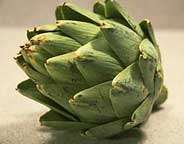Cookbook:Artichoke
Cookbook | Recipes | Ingredients | Vegetable
| Basic foodstuffs

The artichoke is a giant thistle flower bud. It is sometimes called the globe artichoke, or French artichoke to avoid confusion with the sunchoke, which is an entirely different plant that sometimes goes by the confusing name "Jerusalem artichoke".
Unlike most vegetables, only a very small part of the artichoke is actually edible — the very bases of the "leaves" and the interior heart. The heart of the flower is topped with spiky bristles or hairs that would be unpleasant to consume, and the leaves are extremely tough and fibrous.
Artichoke hearts are often sold in a pickled or preserved form, and served as part of an antipasto dish at the beginning of a meal.
Selection and Storage
High-quality artichokes are usually compact and heavy for their size. Squeezed, a fresh artichoke will make a squeak. The thickness of each stalk should correspond to the size of the artichoke. Thin stalks signal dehydration, so look for stalks that are firm without “give.”
Artichokes remain fairly constant in appearance for weeks, but flavor is adversely affected from the moment they are cut from the stalk. For maximum taste and tenderness, cook as soon as possible. Do not stock up on artichokes. Refrigerate unwashed, in a plastic bag, for up to 1 week.
Cooking
Start by cutting the thorns off with kitchen scissors or simply take a kitchen knife and cut straight across the top part off the artichoke. This will leave a flat top on the artichoke. Note that "thorn-free" artichokes, besides having far less of the edible part, generally do have little hidden thorns that are hard to remove.
Artichokes should be very well cooked. This is required to soften them enough to eat. Make sure to check the water level as the artichoke will absorb water as it softens. Add more water if they are still not tender and continue to cook. Unlike most vegetables, artichokes should be cooked until they are a darker color green than when they were fresh.
Artichokes may be boiled, microwaved, steamed, or pressure cooked, although steaming is best. When steaming, spread the leaves a bit and place the artichokes stem-end-up to ensure that plenty of steam gets to the inside. Microwaving is essentially steaming; cover the artichokes and add a bit of water.
You may want to stuff the artichokes prior to cooking. They can be stuffed with ground beef, rice, or anything you prefer.
Eating

Although people from artichoke-growing regions (and many of their descendants) are very familiar with the artichoke, people from elsewhere rarely encounter this vegetable and eating one can be a trap for the inexperienced.
After cooking, the large leathery "leaves" forming a tight rosette are pulled off one by one, and their soft, inner basal part (usually) is dipped in some kind of sauce, perhaps mayonnaise or vinaigrette. The dipped soft part is then scraped off with the teeth and all the rest of the leaf discarded — absolutely not to be eaten. The fleshy, edible part is delicious, but quite sparse in proportion to that which is discarded.
This process continues until most of the leaves have been removed and the remaining ones are too small and delicate to eat in this manner. This point is difficult to judge and the novice artichoke eater may wish to seek guidance by discreetly watching a companion.
With the softest inner leaves, there is no need to scrape away a layer using the teeth. Pull these leaves off in bunches of perhaps 10 to 20, folding as needed to bunch up the lower edge, then dip the lower edge in the sauce and bite it off. Discard the upper portion, which may contain thorns.
Finally, an irritating fur-like layer of thistle is exposed. This layer can be pulled out, scraped out, scooped out, or cut out. It is generally best to scrape the thistle away with a sideways motion of a dull table knife (a butter knife). Some practice will be required. If this process is difficult, it is likely that the artichoke was not cooked enough.
The remaining part, minus any stem still attached, is the artichoke heart. This is often considered the best part of the artichoke. Dip it in sauce and eat it.
It will be seen that the art of eating this food is in itself a satisfying and time-consuming matter which has wider implications than mere nourishment.
Seasonality
| Seasonality tables|Autumn|Winter|Spring|Summer|All year | ||||||||||||
|---|---|---|---|---|---|---|---|---|---|---|---|---|
| Artichokes | Jan | Feb | Mar | Apr | May | Jun | Jul | Aug | Sep | Oct | Nov | Dec |
| northern hemisphere | ||||||||||||
| southern hemisphere | ||||||||||||
Most species of artichoke have their peak season in spring, but some species produce all year round (with some having their peak in autumn), especially in locations closer to the equator. Artichokes harvested in the winter and spring will be globe-shaped, whereas artichokes harvested in the summer and fall will be more conical.